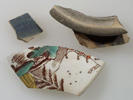 |
Islamic Culture in Nubia
With the assistance of the Mamluk rulers of Egypt, the Kingdom
of Makuria fell to the Juhayna Arabs through a combination
of conquest and intermarriage in the mid 14th century. Nubia
quickly adopted the Arabic language and the religion of Islam.
The Dongola Reach soon came under the sway of the far-flung
Funj kingdom, or al-Saltana al-Zarqa (the Black Sultanate).
Mohamed Ali Pasha, Ottoman Turkish ruler of Egypt, conquered
Sudan in 1821, but the Mahdi overthrew the Egyptian colonial
government in 1881. Sudan enjoyed a brief period of independence
under him and his successor the Khalifa Abdallahi. British
General Lord Kitchener defeated the Mahdist army led by the
Khalifa in 1898 at the Battle of Omdurman, bringing Sudan
under Anglo-Egyptian colonial rule until it gained independence
from Egypt in 1956.
These struggles are reflected in the survey area by several
substantial Qasr (fortresses) and Diffi (fortified mansions).
Qasr Khandaq was the oldest, going back to Christian times.
Qasr Wad Nemeri was the largest, accompanied by over forty
Qubbas, domed funerary monuments to important individuals
and holy men or sheikhs. The fortress at el-Kab was perhaps
connected to the famous Darb al-Arba'in (Forty Days Road),
a key route funneling camels, slaves, and valuable trade goods
into Egypt.
Artifacts

| Islamic pottery from the Sudan is
often hand made with incised decoration. |
|

| Imported porcelain and glass beads came from Europe
and China. The chunk of coral must have come from
the Red Sea. The small incised and impressed bowls
are from Turkish pipes. |
|

| The copper Egyptian 5 piaster coin found at Qasr
Wad Nemeri is dated 1898, perhaps dropped there
by one of Kitchener's soldiers on his way to defeat
the Mahdist army of "Dervishes" at Khartoum. |
|
|
